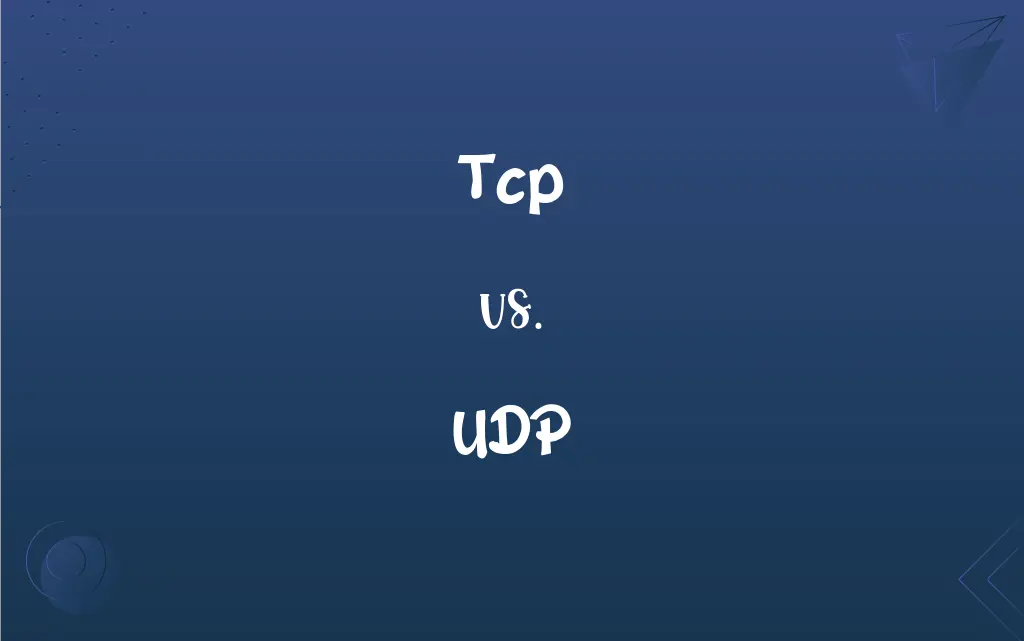TCP vs. UDP: What's the Difference?
Edited by Aimie Carlson || By Harlon Moss || Updated on October 9, 2023
TCP (Transmission Control Protocol) ensures data accuracy and order in transmission, establishing a connection. UDP (User Datagram Protocol) transmits data without connection, favoring speed over reliability.

Key Differences
TCP, or Transmission Control Protocol, is a communication protocol that facilitates the exchange of messages between computing devices in a network. It is characterized by forming a connection between two points before transmitting data, ensuring data reliability and order. On the other hand, UDP, or User Datagram Protocol, is a connectionless protocol, which means it sends messages without establishing a connection, offering speedier data transmission.
In TCP, data transmission is thoroughly checked for errors, and lost packets are retransmitted, ensuring data integrity throughout the communication process. Contrarily, UDP does not provide error checking or recovery of lost packets, which can result in errors in the transmitted data, especially in unstable network conditions. This fundamental difference showcases TCP's emphasis on reliability and UDP's focus on rapid data transfer.
In practical applications, TCP is employed in scenarios where data accuracy is paramount, such as in file transfers, email communications, and web browsing, where receiving complete and error-free data is crucial. Conversely, UDP is favored in real-time applications like video streaming, gaming, and voice over IP (VoIP), where low latency and high-speed data transmission are more critical than ensuring data accuracy and completeness.
An important distinction in the application layer interaction is that TCP establishes persistent connections until data transmission is completed, ensuring that each packet reaches its destination in the correct order. UDP, in stark contrast, sends packets independently of one another, potentially resulting in out-of-order arrival or packet loss, making it more suitable for applications where timely delivery outweights the need for precision.
Despite the apparent opposition in the application of TCP and UDP, it is the unique attributes of each protocol that determine their appropriateness in various applications. TCP's reliability and data integrity make it suitable for applications requiring thorough data verification, whereas UDP’s minimal delay and reduced overhead find a niche in applications where real-time data transmission is the priority, thus both protocols cater to a wide range of network communication needs.
ADVERTISEMENT
Comparison Chart
Connection
Connection-oriented
Connectionless
Reliability
Highly reliable
Less reliable
Transmission Speed
Generally slower due to error checking
Faster, as there is no error checking
Usage Scenarios
Web browsing, email, file transfers
Video streaming, gaming, VoIP
Header Size
Larger (20-60 bytes)
Smaller (8 bytes)
ADVERTISEMENT
TCP and UDP Definitions
Tcp
TCP includes error-checking mechanisms that enable the retransmission of lost or erroneous data packets.
During file transfers, TCP ensures any lost packets are resent to maintain file integrity.
UDP
UDP does not guarantee data delivery or order, prioritizing speed and low latency in communication.
During a live video stream, UDP allows continuous streaming even if some data packets are lost.
Tcp
TCP ensures that data packets are delivered in the order they were sent, maintaining communication coherence.
When loading a web page, TCP assures that images and text appear as intended by maintaining packet order.
UDP
UDP transmits data with minimal overhead, making it efficient for applications requiring low latency.
VoIP calls often use UDP to ensure that voice data is transmitted with minimal delay.
Tcp
TCP is a connection-oriented protocol ensuring data reliability and order during network communication.
Web browsers utilize TCP to ensure that web page data loads accurately and in order.
UDP
UDP allows broadcasting to multiple recipients, facilitating data transfer to many users simultaneously.
A network admin might use UDP to send system alerts to all users on the network simultaneously.
Tcp
TCP establishes a dedicated communication pathway between two network endpoints before data transmission.
When sending an email, TCP establishes a secure path, ensuring the message is delivered accurately.
UDP
UDP is a connectionless protocol that allows data to be sent without establishing a dedicated connection.
In online gaming, UDP enables fast, real-time data transmission to maintain gameplay fluidity.
Tcp
TCP performs flow control, moderating the rate of data transmission based on network capabilities.
If a network becomes congested, TCP can adjust the data transmission rate to avoid packet loss.
UDP
UDP is stateless, meaning each packet is independent and does not relate to the previous or subsequent packet.
In IoT devices, UDP might send independent data readings without needing continuous connectivity.
Tcp
A protocol developed for the internet to get data from one network device to another;
TCP uses a retransmission strategy to insure that data will not be lost in transmission
FAQs
Does TCP guarantee the order of data packet delivery?
Yes, TCP ensures data packets are delivered in the correct order.
Is TCP connection-oriented?
Yes, TCP establishes a connection before data transmission.
What type of applications typically use TCP?
Web browsers, email services, and file transfers commonly use TCP.
Is TCP suitable for real-time applications?
Generally no, as TCP's error-checking mechanisms can introduce delays.
What does TCP stand for?
Transmission Control Protocol.
What types of applications typically use UDP?
Applications like video streaming, online gaming, and VoIP often use UDP.
Can UDP broadcast messages to multiple recipients?
Yes, UDP can send messages to multiple users simultaneously.
Is UDP considered efficient for real-time data transmission?
Yes, due to its low overhead and minimal delay.
Can UDP handle larger messages than TCP?
No, UDP typically handles smaller messages due to its lower overhead.
How does UDP achieve faster data transmission than TCP?
UDP minimizes overhead and skips error-checking, thereby reducing transmission delay.
What does UDP stand for?
User Datagram Protocol.
Which protocol should I use for live video streaming?
UDP is often preferred for live video streaming.
Which protocol is better for data integrity?
TCP is better for data integrity due to its error-checking and recovery features.
In which scenario would UDP be a poor choice?
UDP might be unsuitable for applications where data order and integrity, such as file transfers, are paramount.
Does UDP guarantee data delivery and order?
No, UDP does not guarantee either.
Which protocol is considered more reliable, TCP or UDP?
TCP is considered more reliable due to its error-checking mechanisms.
Is TCP more secure than UDP?
TCP is not inherently more secure, but its connection-oriented nature can facilitate certain security features.
Which protocol uses more bandwidth, TCP or UDP?
TCP can use more bandwidth due to its error-checking and recovery functionalities.
Can applications use both TCP and UDP simultaneously?
Yes, some applications use both protocols for different data transmission needs.
Does TCP retransmit lost packets?
Yes, TCP will retransmit lost or erroneous data packets.
About Author
Written by
Harlon MossHarlon is a seasoned quality moderator and accomplished content writer for Difference Wiki. An alumnus of the prestigious University of California, he earned his degree in Computer Science. Leveraging his academic background, Harlon brings a meticulous and informed perspective to his work, ensuring content accuracy and excellence.
Edited by
Aimie CarlsonAimie Carlson, holding a master's degree in English literature, is a fervent English language enthusiast. She lends her writing talents to Difference Wiki, a prominent website that specializes in comparisons, offering readers insightful analyses that both captivate and inform.































































